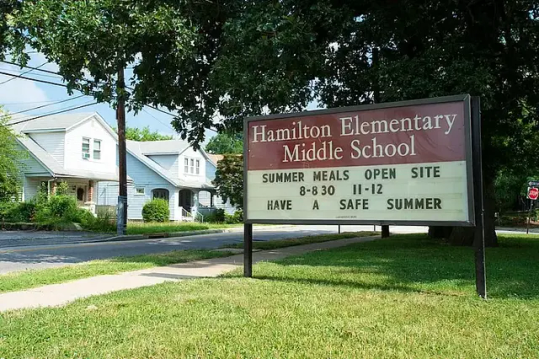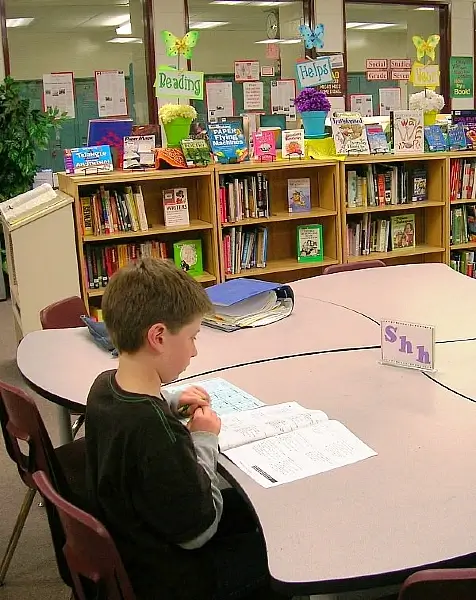#StandardizedexamsinUSeducation
Explore tagged Tumblr posts
Text
Navigating Elementary Education in the USA

Elementary education in the USA encompasses children between the ages of five to eleven, typically from kindergarten through fifth grade. The curriculum focuses on developing foundational skills in core subjects such as mathematics, English language, arts, science, and social studies. However, with increasing emphasis on educational reforms and standards, there has been a growing movement towards incorporating other subjects like technology, art, and physical education to provide a well-rounded education.

Summertime message to all parents and students. Photo by USDAgov. Flickr.
School Dates
In terms of school terms, elementary schools in the USA usually operate on a traditional nine-month calendar. However, some districts have adopted year-round schooling to minimize learning loss during long breaks. Ten percent of US public schools are currently using a year-round calendar instead of the traditional three terms. The basic year-round calendar generates through a 45-15 ratio. This refers to students staying in school for 45 days but then getting 15 days of break. Students do not receive the traditional Thanksgiving break nor the Christmas, spring, and summer vacation, instead, they have more frequent breaks throughout the entire year. This offers both advantages and challenges for students and teachers alike. Shorter breaks help maintain academic progress throughout the year as extended periods away from school can disrupt routines and make it challenging for students to retain learned knowledge. Opposition to this change has come from businesses that rely on summer leisure as well as summer camps and amusement parks. Some opposition is led by parents who value the long summer vacations. Rural areas rarely use year-round calendars because they conflict with farms' need for youth labor in summer.

HAS students spearhead donation drive for Iraqi children. Photo by USAG-Humphreys. Flickr.
Encouraging Curiosity and Creativity
Overall, elementary education in the USA strives to prepare young learners for their future academic journey by building essential skills while fostering creativity and curiosity in an inclusive environment. Teachers do this by teaching children a variety of skills that can boost their creativity, encouraging them to think out of the box, and encouraging them to share their ideas with the rest of the class. Vital to all this is the constructive feedback and assistance given by both their peers and the teachers. As education continues to evolve with the changing needs of society, it is crucial to ensure that elementary schools strike a balance between imparting core knowledge and nurturing individual talents to allow for holistic development.

Elementary school student taking a test in a school library. Photo by Enokson. Flickr.
School Assessment and Tests
Schools use grades to score a student’s performance in class. The grades can be based on things like class participation, homework, projects, and tests. Grades show the teacher what a student knows and they will help determine whether a student can take advanced classes or whether they need extra help. These grades are typically represented with letters (A, B, C, D, F) or numbers (90, 80, 70). ‘A’ is the highest grade and ‘F’ means a student did not pass. Some schools use a Grade Point Average (GPA) system as well as a letter grade. A GPA calculates a student’s academic performance over a specific period, such as a semester or academic year. Younger students might get alternatives to grades that simply state if the child is meeting age-level standards. Elementary education in the USA is a complex system that has evolved over the years to meet the needs of its diverse student population. One unique aspect of elementary education is the emphasis on standardized exams. Students in the USA regularly take standardized tests, which are different from the tests they take in their regular classes. All standardized tests are designed in the same way and are given to all children under the same conditions. The results measure how well both the students and schools are doing. These exams, such as state assessments and national tests, hold immense importance for both students and schools. While some argue that this focus on exams stifles creativity and limits educational experiences, others see them as necessary benchmarks for ensuring quality education.
School meals
Food plays an interesting role in elementary education. The National School Lunch Program (NSLP) provides low-cost or free lunches to children and operates in nearly 100,000 public and non-profit private schools (grades Pre-Kindergarten–12). School meals are provided free of charge, or at a government-subsidized price, to United States students from low-income families. These free or subsidized meals have the potential to increase household food security, which can improve children's health and expand their educational opportunities. In this school year (2023), the median cost for breakfast is $1.73 and for lunch is $2.75. This can be compared to elementary schools in England where free school meals are provided universally to all children who are in reception, year 1, and year 2, and some councils provide free school meals universally for children in all elementary school years. School lunches have long been a subject of debate in the USA, with concerns ranging from nutrition and health to affordability and accessibility. The introduction of healthier options in recent years has aimed to address these concerns, but challenges persist. Students' dietary preferences also vary immensely across different regions, making it essential for schools to strike a balance between providing nutritious meals and catering to cultural or regional food preferences.
Role of Teachers in Elementary Schools
Teachers are at the heart of any successful educational system, and this holds for elementary education in the USA. To become a teacher a person needs to obtain a Bachelor's Degree, complete the state requirements for teacher licensing (which takes approximately 3 months), and then complete a period of supervised teaching for up to one year. Teachers play multiple roles in schools. In addition to being instructors, teachers act as mentors, they provide role models and they act as motivators. They face many challenges which range from managing large class sizes to adapting teaching methods for diverse learning styles. Teachers also face constant pressure to provide effective education while fostering a positive classroom environment. To be successful, teachers need to demonstrate appropriate subject knowledge and understanding, address misconceptions, manage behavior effectively, set challenging homework, and have high expectations of their students. In addition, a teacher needs many attributes: an understanding of the way individual students learn; the ability to show empathy towards children's needs, and help nurture a love for school. Teacher's enthusiasm (real or passionately faked) will directly impact not just how a class sees a subject, but their whole learning environment and their attitude toward school as a whole. Finally, teachers must act as a leader.
Getting to School
Transportation is another intriguing aspect of elementary education in the USA. If children live near to a school, they may walk but often the distances are too great for this. Many students rely on school buses or other forms of transportation provided by their district to get to school safely every day. About 25 million children in the US – more than half of the nation's schoolchildren – take school buses, according to the American School Bus Council. Some of these buses are even Wi-Fi-equipped. Alternatively, some children commute to school by car or, in a big city, by subway train. However, there are issues like transportation funding gaps and inadequate infrastructure which can hamper children getting to school.
Class Size
Class sizes have long been a contentious issue in elementary education in the USA. While some argue that smaller class sizes allow for more individualized attention and better learning outcomes, others believe that larger classes can foster collaboration and social skills. However, recent studies have shown that the optimal class size is not a one-size-fits-all solution. In the USA, class sizes vary from state to state, ranging from 16 to 24 children per teacher in elementary schools. In Vermont, it is 16.4 whereas California is 24.2 children per class on average. Factors like student demographics, teacher quality, and community resources play vital roles in determining the effectiveness of education. Thus, some would argue that it is important to consider a comprehensive approach to improving education rather than solely focusing on reducing class sizes.
The Debate Over a Standardized Curriculum
Another hot topic in elementary education is the debate over a standardized curriculum. Critics argue that a standardized curriculum stifles creativity and limits teachers' ability to tailor instruction to meet individual student needs. However, supporters believe that a uniform curriculum ensures consistency across schools and creates equal opportunities for all students. Elementary education in the USA stands apart from many other countries due to its diversity and decentralized structure. While some nations have a centralized, standardized curriculum, such as Finland's highly regarded system, the United States grants more autonomy to individual states and school districts. This decentralized approach allows for flexibility but also leads to inconsistencies in quality and standards across the country. Furthermore, when comparing elementary education in the USA with that of other countries, it is essential to highlight variations in educational philosophy and priorities. For example, compared to countries like South Korea or Japan where test scores play a significant role in shaping curriculum and instruction, American schools tend to emphasize creativity, critical thinking, and social development alongside academic performance. This difference suggests that while standardized testing remains an important part of American education, there is a recognized need for holistic learning and fostering well-rounded individuals.
Success Rates in Elementary Education in the USA
One of the most pressing concerns in elementary education in the USA is the success rates of students. While standardized testing has long been used to measure educational achievement, it often fails to capture the full range of a student's abilities and potential. As a result, many educators are turning to alternative methods of assessment that focus on growth and individual progress. By shifting away from a narrow emphasis on test scores, teachers can better support their students' unique learning needs and foster a more inclusive and effective learning environment. Furthermore, there is increasing recognition that success in elementary education cannot be solely attributed to academic achievement. Social-emotional skills play a crucial role in a child's overall development and future success. As more attention is being given to fostering these skills, schools across the country are implementing programs that prioritize emotional intelligence, empathy, resilience, and problem-solving abilities. By nurturing these qualities alongside traditional academics, educators aim to produce well-rounded individuals who can thrive personally and professionally in an ever-evolving world. Social Influences Elementary education in the USA is a complex landscape where factors like poverty and ethnicity play significant roles. It's no secret that poverty affects academic performance, and unfortunately, this reality is vividly reflected in elementary schools across the country. Students from low-income backgrounds often lack access to proper resources, which leads to achievement gaps between them and their more privileged peers. The challenge becomes even more daunting when considering the impact of ethnicity on elementary education. Research shows that students from ethnic minority groups face additional barriers to success in the classroom. Ethnicity plays a crucial role not only in terms of cultural identity but also when it comes to educational opportunities. The disparities are multifold: unequal distribution of resources, cultural biases embedded within curricula, and limited access to high-quality teachers who understand diverse learning needs. These existing disparities highlight the need for a comprehensive approach that tackles both poverty and ethnicity head-on in order to provide equitable elementary education for all students. To address these challenges effectively, educators and policymakers alike acknowledge the intersectionality of poverty and ethnicity within the context of elementary education. By focusing on tailored interventions such as targeted support programs, culturally relevant curriculum design, mentorship initiatives from relatable role models, and investment in community-based organizations working directly with marginalized populations, the USA is beginning to close this persistent gap. Ultimately, creating an inclusive educational environment starts with recognizing that tackling poverty alone won't solve all the problems faced by ethnically diverse students in elementary schools. A holistic approach must be taken.
Use of Computers in Elementary Schools
Computers have become an integral part of elementary education in the USA, revolutionizing the way children learn and teachers instruct. Gone are the days of blackboards and chalk; interactive whiteboards and tablets now take center stage. However, this shift has raised concerns about screen time and its impact on young minds. While technology undoubtedly offers immense educational benefits, it is essential to strike a balance to ensure that children engage with diverse learning experiences beyond the virtual world. Despite technological advancements, schools are encouraged not to overlook traditional teaching methods when it comes to elementary education. Computers in school can provide interactive lessons and personalized learning opportunities but they cannot replace human interaction or stimulate certain skills adequately. Building social connections, developing emotional intelligence, and fostering creativity – are areas where traditional teaching methods shine. When schools combine technology with traditional approaches this seems to be the key to achieving all-round development in young students. Computers have undoubtedly transformed elementary education in the USA for the better by providing new avenues for engagement and personalized learning experiences, but blending technological advancements with traditional teaching methods has shown to create a well-rounded educational environment for our young learners – one that fosters critical thinking skills while also nurturing children's social-emotional growth.
Conclusion
Finding effective solutions for education in the USA requires considering diverse factors such as class sizes and standardized curriculum within a broader context. Elementary education in the USA presents both strengths and weaknesses when measured against systems found in other nations. The decentralization of authority ensures flexibility but can lead to disparities among schools. Additionally, American schools place value not only on academic achievement but also on fostering creativity and social skills among students. Understanding these unique aspects helps shed light on the challenges facing elementary education in America while showcasing its commitment to comprehensive growth among students. Sources: THX News, Wikipedia & American School Bus Council. Read the full article
#Alternativeassessmentineducation#ClasssizesinUSschools#Computersinelementaryeducation#ElementaryeducationintheUSA#Povertyandethnicityineducation#Roleofteachersineducation#SchoollunchesintheUSA#StandardizedexamsinUSeducation#Successinelementaryeducation#USelementaryschoolcalendar
0 notes